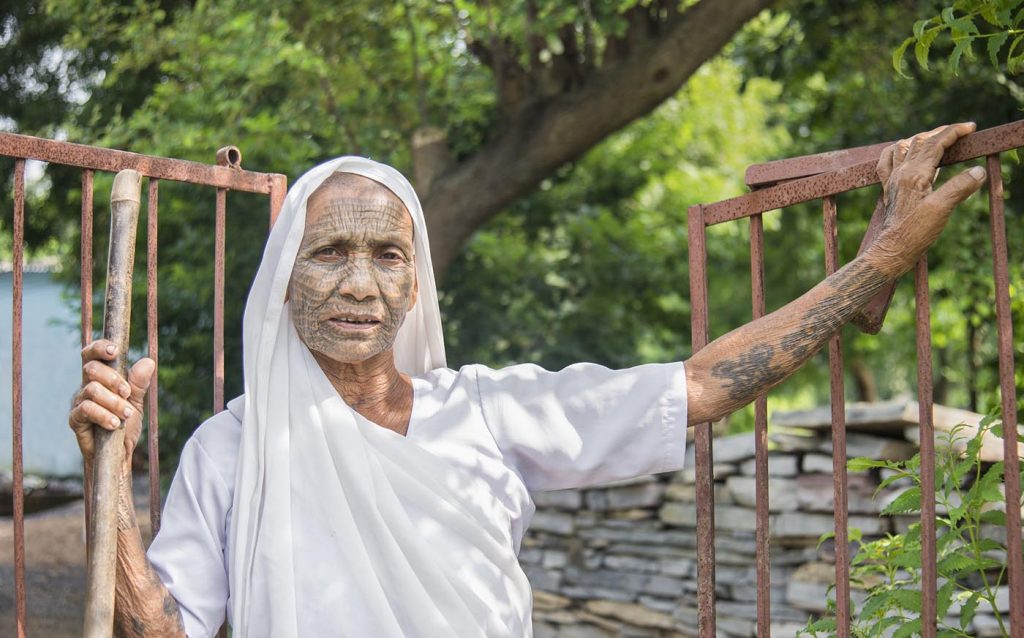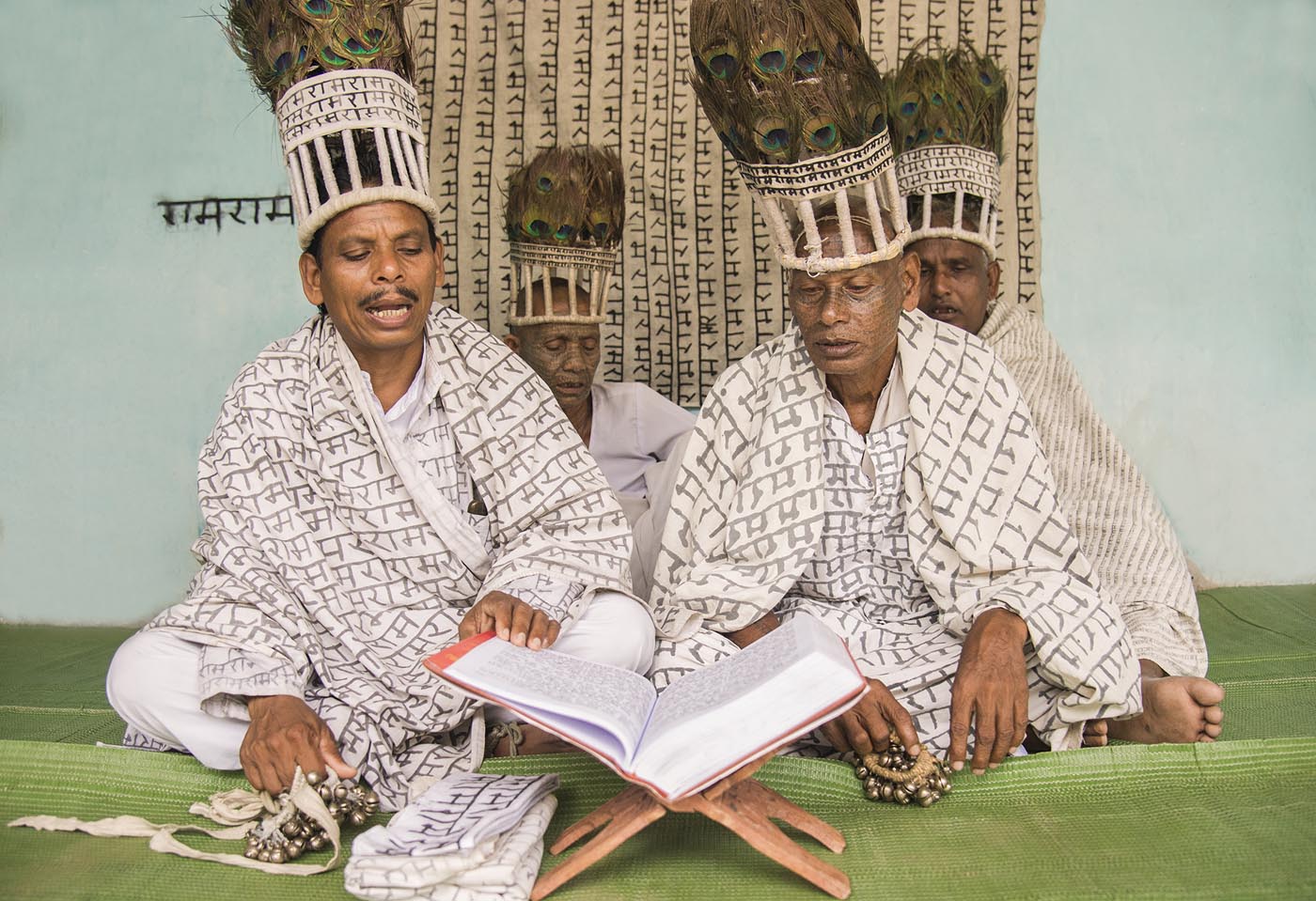Meet the Ramnamis, a small community in central India whose elders are boldly tattooed in Lord Ram’s name
Photos and Text by Anne Petry
Several years ago, by sheer chance, I saw a picture of an old, skinny, wrinkly person wearing a simple printed black and white cloth and with tattoos on her legs, arms and face. I remember I stayed astonished in front this portrait, not only because of the full body tattoo, but because somehow through this photo I could feel the devotion and the faith this individual seemed to have for her God.
After some research, I discovered that the woman in the picture belonged to the Ramnami Samaj community, a religious movement inside Hinduism that worships Lord Ram. Because they belong to one of the lowest castes, in past times they were banished from temples. And this is why they decided to turn their bodies into their own temples by tattooing all over the name of their God, Ram. This was not meant as a protest against upper castes nor to take any revenge. It was just a way to respond to not being able to go into temples. Ram was inside their hearts and minds as well as on their bodies; the tattoos reminded them always of their Lord. They could pray to Him no matter where they were, no matter what time it was and regardless of any exclusionary rule.
What a radical and incredible way to step up for their beliefs, isn’t it? At that time, it was clear for me: I had to meet those people who were not afraid to change their body appearance in order to claim their devotion.


A few years later, here I was in India searching for a way to meet the Ramnamis. I had read that they never left the banks of Mahanadi River and lived in a small number of villages spread across the densely forested state of Chhattisgarh, known for its beautiful temples and majestic waterfalls. But how to get in touch and how to communicate with them, I wondered, when I didn’t speak Chhattisgarhi, the local dialect, or any other variety of Hindi, and the elders didn’t speak English. But I guess the meeting was meant to happen, as a few days after my arrival in Raipur (Chhattisgarh’s capital) and a long bus ride to a remote village, I found myself surrounded by the Ramnamis.
While the young generations were smiling and so willing to talk, the elders were quiet and reserved. What impressed me right away from those old tattooed Ramnamis was the peaceful energy that emanated from them. No matter the kids shouting and running around, no matter the teenagers watching noisy video clips on their phones—the seniors remained calm and focused, calling out every few minutes, “Ram Ram.”
I quickly realized that their God is present everywhere in their lives, from morning to evening, all day long, since “Ram-Ram” has so many meanings, including “good morning,” “good night,” “goodbye,” and “thank you.” In accordance with the beliefs of the Ramnami Samaj movement, followers are encouraged to continuously recite the name of Lord Ram as frequently as possible. Therefore while they are working in fields, cooking, walking or riding a bicycle, “Ram” is like a mantra that is chanted uncountable times every day.




To produce the ink that is used to brand their skin with “Ram Ram,” they burn kerosene oil under an earthen pot, then collect the resulting soot from the inside surface of the pot. The soot is then mixed with a little water.
It is believed that this tradition started in the 1890s, but no clear report mentions any precise date, nor the name of the first person who in this way dealt with the pain of not being able to go to temples. But there is a legend saying that Parsuram Bharadhwaj, a low-caste man suffering from leprosy, was once blessed by a sadhu who told him to read Tulsidas’ book Ramacharitmanas. The following day, to Parsuram’s amazement, the marks of his illness had disappeared and his body had been miraculously tattooed with the words “Ram Ram.” This event is said to have marked the beginning of the Ramnami Samaj movement, and is considered to be a divine intervention by Lord Ram himself.
Nowadays, caste-based discrimination being banished since 1955, and because of studies, work and fashion, of course, the practice of tattooing the name of Lord Ram on the body has largely declined. Based on available information, it appears that only a few of the elder members, aged 60 years and above, still have the distinctive “Ram Ram” tattoos on their bodies. Furthermore, of the many Naksikh (full-body-tattooed individuals) who were once part of the Ramnami Samaj community, only two are believed to remain.




Pitamber was 40 years old when he got his face, skull, chest and back tattooed; although shy, even reserved, the Ramnamis are proud of their tattoos and always happy to talk
Knowing all this and having clearly in mind that the tradition is definitively vanishing, it felt like a rare privilege to spend some time with them. When I asked Setbai, 70 years old, if it was painful to get her face tattooed, her answer was prompt and firm: “No, it was not, because I did it as bhakti, as pure devotion to the God I believe in.” Pitamber, who tattooed his face, skull, chest and back when he turned 40, confirmed: “When you do something like tattooing your body for good reasons, because you truly and fully have faith in your beliefs, then nothing hurts!” How powerful were those words for a Western woman like me, who always saw tattoos only as a trend and never thought they could be used as a powerful statement, let alone a spiritual declaration.
Soon after my arrival, when it was already night, Ramnamis from the neighborhood gathered to pray. All wore an odhani, a white shawl. with black inscriptions of Ram printed on it, a headgear called mukut made of peacock feathers, and a few ghunghru clutches of bells in their hands. A copy of the holy Ramayana epic, a book on Lord Rama’s life and teachings, was put in the center of the circle. They were ready to start the bhajans! In the Ramnami Samaj community there is no hierarchy or priest. Therefore, whoever feels the desire can start singing the verses written in the holy book, and the others will follow by chanting “Ram Ram.” Being so accustomed to praying together, only a few seconds were necessary to find the right tempo and to sing in unison.




Prayers are always performed in the same simple way, with the Ramnamis sitting on the floor, chanting Ram’s name for hours, reading the Ramcharitmanas and a few of them dancing around, their small ankle bells tinkling. They pray this way to celebrate every important moment in life from birth to death, including weddings and for the simple joy of being together to honor their common God. Being part of this ritual, surrounded by Ramnamis in a remote village, was a mystical and unforgettable experience.
Spending several days living with a Ramnami family, I was surprised not to see any altar in the house, nor did I witness any offerings. So I asked my host, Gularam, the General Secretary of the Ramnami Samaj community about it. The beauty of his answer left me speechless. His statement was clear: “We are free of rituals because we believe God is everywhere, in the five elements (earth, water, fire, air, space), in plants, animals and humans; therefore being good and kind toward all of them is the best way to show our devotion to Ram.” Respecting each human being, regardless of caste, color of skin or way of life, protecting animal lives by being vegetarian, living in accordance with nature by respecting the seasonal crops and finally, esteeming their own lives by not smoking nor drinking alcohol, those are some of the main principles followed by the Ramnamis.


Also, the name of Ram that you find written in so many places, from the inner and outer walls of their houses to their own skin, is so sacred that unlike other Hindus, when someone dies, after nine to ten days of celebrations, Ramnamis actually bury the deceased body instead of burning it. By doing this, the name of Ram is not destroyed but maintains His holy power.
Does the power of Ram still have such a strong impact on the youngsters’ beliefs and lives? For centuries, Ramnamis had a humble way of life and were almost exclusively farmers, but their lifestyle changed about two or three decades ago. Modernity and access to education gave the opportunity to the latest generations (mostly young men) to leave their villages to study and work in town. Slowly they gave up the tattoo practice. In the past, the first tattoo was marked in the center of the forehead; it became more common to place it on an arm or any other body part that could be hidden under clothing.




Still, leaders of the community I spoke to are convinced that their youngsters will not forget the love and the fidelity they have for Ram. Because it has been engraved in their minds since their early age, they will keep on honoring their God in their own ways. In fact, as I spent quite some time with young Ramnamis, I can testify that they seemed proud of who they are and glad to be part of this community.
During my stay in their village, I spent time with the Ramnamis and got to know them better. I found that the elderly people, who had seemed a bit distant when I first arrived, turned out to be some of the sweetest people I had ever met. Even though we didn’t share a common language, there was a non-verbal communication between us that was more powerful than any spoken word. Smiling, touching hands, gazing deeply, those acts are beyond words yet understandable in every human society, despite differences in nationality or religion. In that way, I could say that the elderly Ramnamis and I simply spoke the language of sharing and respect.
I feel blessed to have met these extraordinary and unique persons, not just because they have their faces and bodies tattooed, but because they represent a kind of people that is simply disappearing in our standardized society. I am talking about those who don’t mind being different, those who treat everybody with equality and consideration, and finally those who see the beauty of God everywhere and in everything.




About the author


Anne Petry is a French photo-grapher focusing on indigenous populations. Her nomadic life takes her from the Himalaya to the natives in Mexico, from the Shamans in Amazonia to the Hindu priests in India. She is passionate about people who keep alive their beliefs and traditions. Contact Instagram: annepetryphotography


